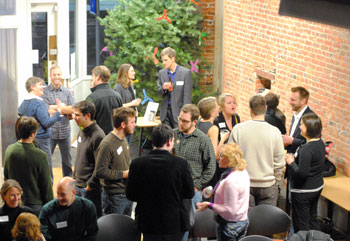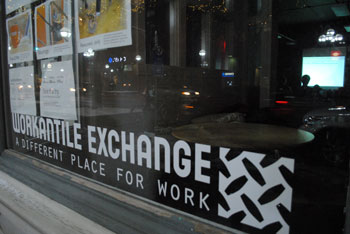Active Use of Work Space: Film Premiere
On Wednesday night at the Workantile Exchange – a membership-funded coworking space on Main Street, between Washington and Huron – local video producer and urban researcher Kirk Westphal premiered his two newest films.

Pre-premiere socializing at the Workantile Exchange for films on urban planning and forms of local government. (Photos by the writer.)
The first film, “The Great Street Toolkit,” focuses on urban planning. The second, “The Council-Manager Form of Local Government,” is an introduction to how the council-manager system is different from a strong mayor system. The city of Ann Arbor uses a modified version of the council-manager form.
As Westphal himself noted lightheartedly, it was the “true wonks” in the audience who stayed for the second film – on council-manager government.
And it turns out that most of the 30 people in the audience were true wonks.
But linked indirectly to the evening in multiple ways was one person who was not in the audience at all – local developer and downtown property owner, Ed Shaffran.
The wonks included people like Wendy Rampson, head of planning for the city of Ann Arbor; Ed Koryzno, Ypsilanti’s city manager; Diane Giannola, Ann Arbor city planning commissioner; Doug Kelbaugh, former dean of the University of Michigan’s Taubman College of Architecture and Urban Planning; and Steve Bean, recent independent candidate for mayor of Ann Arbor.

Doug Kelbaugh, former dean of the University of Michigan College of Architecture and Urban Planning, talks with Wendy Rampson, head of Ann Arbor's planning staff.
Westphal, a video producer and urban researcher, will be recognizable to many Chronicle readers as one of the city’s planning commissioners; he also serves on the city’s environmental commission. His previous work includes the film “Insights into a Lively Downtown,” a case study of Ann Arbor.
Each of Westphal’s new films had a running time of 23 minutes, and there was opportunity for the audience to discuss the content of the films before, between and after the showings. Prompting much of the discussion was how the material in the “Great Street” film relates to the Washington-to-Huron block of Main Street, where the Workantile Exchange itself is located. The Washington-to-Huron block includes a number of banking opportunities: Citizens Bank, Chase, KeyBank, and PNC Bank. In addition, Comerica is located just north of Huron, in the One North Main building.
But as the “Great Streets” film makes clear, neither professional planners nor Westphal are fans of banks as a ground-floor use in a downtown environment. [The film was funded in part by a grant from the Urban Design and Preservation division of the American Planning Association.]
Westphal has expressed the same view before, most recently in an early November presentation he made to his colleagues on the planning commission. Describing a surveillance camera photo of a bank robbery in progress, said Westphal: “What I’d like to convince you of tonight is that there are two crimes being committed in this photo. I contend that what this thief is stealing from the bank doesn’t even come close to what underused banks, like this one, steal from the vitality of a downtown.”
And in an opinion piece published in the April 5, 2009 Ann Arbor News, Westphal expressed the general view that ground floor uses should be regulated in the zoning code to give preference to “active uses” – like retail stores, cafes and restaurants.
So how did Ed Shaffran factor into the evening?
When Westphal’s opinion piece was published in The News, it appeared side-by-side with one from Shaffran, who’s a downtown property owner and developer, and who offered a view opposing Westphal’s. From Shaffran’s piece: “On a theoretical level, to say a bank is not an active use and should be located to a secondary street borders on National Socialism.”
The impetus for the two opinion pieces was the city’s A2D2 rezoning initiative for downtown Ann Arbor, which at the time was being debated by the city council. The original A2D2 proposal included some restrictions on ground-floor uses in certain areas – preference was given to active uses. But those restrictions were removed from the version of the A2D2 rezoning that was approved by the Ann Arbor city council in November 2009.
And Shaffran, as it turns out, was featured in a serendipitous cameo in Westphal’s “Great Streets” film, which included footage shot by Westphal in downtown Ann Arbor. In the frame, Shaffran can briefly be seen walking towards the camera east along Liberty Street, talking on his cell phone.

At left: Jesse Bernstein, chair of the board of the Ann Arbor Transportation Authority, chats with Ray Detter, president of the Downtown Citizens Advisory Council, before the film premiere. In the foreground is Trek Glowacki, co-owner of the Workantile Exchange.
Another Shaffran connection to the film premiere: He owns the building at 118 Main St. that houses the Workantile Exchange, where the films were shown.
And it was the Workantile Exchange itself that generated some of the conversation after the “Great Streets” showing. Why? Parade examples of non-active uses of space are banks and offices. And the coworking space offered by the Workantile Exchange is somewhat similar to shared office space. Does coworking space constitute an active use in an urban planning sense?
The day before the showing, Trek Glowacki, co-owner of the Workantile Exchange, explained to The Chronicle that one key difference between a coworking space and a shared office arrangement is the business model. In a shared office space, every tenant would have an assigned desk, and the rent for the space would be divided equally among the tenants. If a tenant moves out, the remaining tenants would pay slightly more rent. If tenants were added, the rent would decrease accordingly.
In contrast, the Workantile’s coworking space doesn’t guarantee a permanent desk in a specific location. The furniture is on wheels, and will be configured differently on any given day, depending on who shows up to work, when they show up, and who they might be collaborating with. The Workantile is calibrated to a culture that is inherently more collaborative than an arrangement where the only expectation is that you pay the rent for your desk. This community of coworking is a key part of what Glowacki describes as the Workantile’s role in the city’s economic development.
So, the monthly fee paid to the Workantile is not a desk rental, but rather a membership that gives access to a working community and the expectation of a contribution to that community. The space itself includes all the typical amenities that you’d expect in an office, including access to two conference rooms.
The configurable space inside the Workantile makes it suitable for hosting various kinds of events. For example, on Friday, Dec. 3, the same day as Midnight Madness in downtown Ann Arbor, author David Erik Nelson, a Workantile member, hosted a book-signing event for his latest title, “Snip, Burn, Solder, Shred.” The book is written for parents who’d like to make things with their kids – like boomerangs. With all the tables rolled to the walls, there was plenty of room to fling the boomerangs around the main floor. The Workantile Christmas tree is now bedecked with boomerangs.
And of course the space is suitable for hosting a film premiere.
So one of questions at the conclusion of the film came from the Workantile’s Glowacki, who told Westphal to be honest: Is the Workantile Exchange an active use of space?
Before answering, Westphal wanted some clarification about what the usage patterns were. Glowacki told him there was generally someone working 20 hours out of every day. Westphal noted that the use was certainly more active when Mighty Good Coffee had its storefront at the front of the space – but in September 2010 Mighty Good moved up the block to a new location at 217 N. Main St. Now, the whole space is occupied by the Workantile.
At a meeting of Workantile coworkers soon after Mighty Good Coffee departed, they discussed possible alternatives for the area previously used by the coffee shop’s store front. One idea batted around at the meeting was rotating window displays showing off the work of members. Attractive windows offering things of interest to pedestrians is one feature that Westphahl’s “Great Streets” film highlighted as important for a vibrant downtown.
From outside the Workantile on Wednesday night, the film premiere taking place on the other side of the glass wasn’t necessarily accessible to every member of the public – the sign on the door indicated a private event was taking place. But through the window it was clear the space was filled with activity.
Dave Askins, editor and co-founder of The Chronicle, is a member of the Workantile Exchange.





